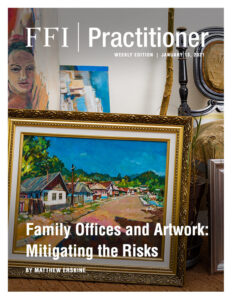
View this edition in our enhanced digital edition format with supporting visual insight and information.
Thanks to Matthew Erskine for this week’s issue discussing the most important steps that family offices and their clients can take to mitigate risk to clients’ collections of art and other collectibles.
Families that use family office services expect family office professionals to help them mitigate risks, both to investments and to concentrated illiquid holdings, such as real estate or closely-held businesses. What sometimes goes overlooked, however, is how to mitigate the risks of ownership of artworks, numismatics, jewelry, cars, and other collectibles. Risk mitigation for these treasures begins with documenting what the client has, aggregating the individual items into collections, and beginning the management of the items as a collection.
Documenting the Collection: What does the client own?
Too many collectors keep the current inventory of items in their heads. Appraisals for insurance purposes often lack critical information or are out of date. Inventories should not only include descriptions of the works but also a list of:
- the artist or artists’ works that are in the client’s possession;
- collaborative creators, artists, or authors;
- dates of both creation and acquisition;
- contracts associated with any works, such as licenses, assignments;
- the items’ locations;
- galleries’ or dealers’ names and contact information; and
- any paperwork that refers to the artwork, such as catalogs, bills of sale, consignment agreements, copyrights, loan agreements, and reproduction rights.
Aggregating the Collections
Every collector has some things that are less significant than others, so the next step is for the client to aggregate the items and the associated paperwork, grouping those works with similar characteristics. This aggregation can be based on the aesthetic of the piece, but can also be based on taxes, recognition, and liquidity premium if the piece was gifted or sold.
Managing and Ensuring the Collection’s Longevity
A family office may be called upon to execute the client’s estate plan and to play an active role in the transferring, buying, and selling of art and other collectibles in the settlement of the client’s estate. Family office professionals need to know how the client wishes his or her collections to be managed after death, specifically in regard to the following issues:
- Understanding the buy-sell discipline for artwork
Family office clients will need the same sort of discipline in managing the ownership of artwork and other investments in tangible property that is provided for liquid investments: namely, when to hold assets until the value recovers, when to sell assets to cut their losses, and when to sell some or all of a type of artwork before the market declines. - Managing the disposition of artwork
In some circumstances, when the artwork is very rare or unusual, a cultural executor, such as a private curator or expert in the field, may be better equipped than family members to manage the disposition of artwork. - Allowing access to funds
Art is not easily liquidated, so alternative sources of funds need to be considered. Life insurance held in a specified irrevocable life insurance trust is one way to provide liquidity. Consider obtaining title insurance to manage transaction risk and to eliminate liability for clients when selling works - Keeping purchase and sale records
The names of galleries, dealers, auction houses, or other individuals who might be interested in buying or selling your client’s artwork should be in a place where your client’s personal representative can readily find them when necessary. - Managing the disposition of any copyrights
Unless the deceased is also an artist, it is unlikely that a client will inherit copyrights; but where there was collaboration between a client and an artist, such rights may exist. - Documenting specific instructions or restrictions on use or licensing
Dealing with restrictions will require significant cooperation with the future owners of the artwork or other items, so any restrictions should be clear and well drafted. The recent changes in the standards of the American Association of Museum Directors allowing the sale of art in a collection and the use of the proceeds for operational costs show that even if there is a stated policy of an institution on the use of artwork, those policies can change. - Properly storing the artwork
Sending a grand piano across the globe may cost much more than the piano is worth, and the beneficiary may not be able to carry those costs without assistance. A client’s visual art collection, in particular, will need to be stored properly, as will photographs, film, and digital files is another example in this category. - Consider using split interest trusts and charitable foundations
In jurisdictions where they are applicable, trusts, LLCs, and limited partnerships may be effective ways to manage investments in tangible property and associated copyrights, licensing, and management costs when the property is to be shared by a number of beneficiaries. In addition to a management trust, clients should be familiar with the use of split interest trusts (e.g., CRT, CLT, GRIT, GRAT) for transferring tangible assets between generations.
Conclusion
To help sustain clients who are new or are longstanding owners of artwork and other collectibles, family office professionals should advise these clients to inventory their tangible assets, simplify their collection process through aggregation, and prepare for the management their treasures when the time comes to pass them on to another generation.
Disclaimer: This article is general and educational in nature. It is not intended to be, nor should be construed as, legal or tax advice.
About the Contributor

Matthew Erskine is the managing partner of Erskine & Erskine LLC, a fourth-generation law firm, and The Erskine Company, LLC, a consulting firm. He focuses on strategic planning and legal services for business owners, professionals, individuals, families, collectors, and inheritors of unique assets, helping his clients and their families solve their problems through customized estate, tax, and management solutions. Matthew can be reached at m.erskine@erskineco.com.

View this edition in our enhanced digital edition format with supporting visual insight and information.





